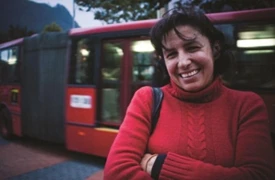Also available in:
Español
Follow the authors on Twitter: @TweetingCamila and @shomik_raj

A commuter in Bogotá, Colombia
(World Bank) When analyzing the modernization of Bogota’s extensive bus system, we read a lot of technical analyses on public transport business models, risks, incentives, etc. But in a city where 11,6% of the population lives below the poverty line, social reality trumps all theoretical studies. In a new report entitled
The promise and challenges of integrating public transportation in Bogotá, experts from Embarq estimate that as many as 23% of bus users sometimes plea for discounted rides, asking the bus driver: “Will you take me for 1,000 pesos?”
This situation points to one of the toughest challenges faced by public transport systems: how to reconcile financial sustainability and social inclusion? On the one hand, if fares do not cover operational costs, systems need subsidies to survive, which can pose serious financial and political risks. In some cases, transport systems operating with inadequate financial resources may experience system deterioration, safety problems and service curtailment. On the other hand, if fares are set to reflect the real price of transport services so that operators can recoup their costs without subsidies, then the poor are often priced out. This is exactly the problem that Bogotá is currently struggling with, despite its well-deserved reputation for innovation and excellence in public transport: fares of its state-of-the-art Transmilenio Bus Rapid Transit (BRT) system are pegged at cost-recovery levels that may price out many of the city’s poorest. Recent studies show that the lowest income households in Bogotá (socioeconomic strata 1, 2, 3 according to the local classification) are already devoting 20-30% of their total income to transportation, spending more than US$2 daily. The situation may be even worse when Bogota’s city-wide public transit reform (the Integrated Public Transport System or SITP) is fully implemented, as bus drivers, with the adoption of smart cards, may no longer be able to offer unofficial discounts to passengers at their discretion, a common practice in the traditional system.
To strike a balance between financial sustainability and social inclusiveness, research suggests that cities should set fares at a level that allows for cost recovery, and then offer targeted subsidies for the poor. In practice, however, offering targeted public transit subsidies for the poor has proved difficult. The first problem has been to accurately identify all the poor who should benefit from a subsidy – particularly those working and living outside the ‘formal’ sector, a vulnerable population that constitutes close to 50% of the population in Bogotá and other big cities in Latin America. Second, there have been implementation concerns, especially concerning subsidized tickets being resold in the secondary market and other forms of abuse that defeat the purpose of the targeted subsidies system. So, for lack of better targeting mechanisms, cities like Bogotá have traditionally granted subsidies to specific socio-demographic groups, such as students, the elderly or the disabled—policies that can make sense for a number of social reasons, but fall short in terms of directly targeting the poor.
But two recent developments suggest that change may be on the way:

"Save 680 pesos on each trip - your contribution to the fare will be 1,020 pesos during peak hours and 720 pesos during off-peak hours" (SITP Bogotá)
There are still areas where this policy needs to be fine-tuned—improving the identification of potential beneficiaries, controlling abuse and leakages via use of smart card and other technologies, securing sustainable sources of funding (particularly via user charges from private auto users to generate cross-subsidies)—but the developments in Bogotá are exciting and create a public transport subsidy program that truly targets the poor.
The priority in the coming months is to assess the impact of the program—its penetration and use among the intended beneficiaries, impacts on their travel patterns and welfare outcomes, and any signs of abuse or unintended side effects. We look forward to reporting back on any lessons we may learn from Bogotá’s experience, as well as any other developments in the use of targeted subsidies to help public transport remain socially inclusive and financially sustainable.
Learn more:
Follow the authors on Twitter: @TweetingCamila and @shomik_raj

A commuter in Bogotá, Colombia
(World Bank)
This situation points to one of the toughest challenges faced by public transport systems: how to reconcile financial sustainability and social inclusion? On the one hand, if fares do not cover operational costs, systems need subsidies to survive, which can pose serious financial and political risks. In some cases, transport systems operating with inadequate financial resources may experience system deterioration, safety problems and service curtailment. On the other hand, if fares are set to reflect the real price of transport services so that operators can recoup their costs without subsidies, then the poor are often priced out. This is exactly the problem that Bogotá is currently struggling with, despite its well-deserved reputation for innovation and excellence in public transport: fares of its state-of-the-art Transmilenio Bus Rapid Transit (BRT) system are pegged at cost-recovery levels that may price out many of the city’s poorest. Recent studies show that the lowest income households in Bogotá (socioeconomic strata 1, 2, 3 according to the local classification) are already devoting 20-30% of their total income to transportation, spending more than US$2 daily. The situation may be even worse when Bogota’s city-wide public transit reform (the Integrated Public Transport System or SITP) is fully implemented, as bus drivers, with the adoption of smart cards, may no longer be able to offer unofficial discounts to passengers at their discretion, a common practice in the traditional system.
To strike a balance between financial sustainability and social inclusiveness, research suggests that cities should set fares at a level that allows for cost recovery, and then offer targeted subsidies for the poor. In practice, however, offering targeted public transit subsidies for the poor has proved difficult. The first problem has been to accurately identify all the poor who should benefit from a subsidy – particularly those working and living outside the ‘formal’ sector, a vulnerable population that constitutes close to 50% of the population in Bogotá and other big cities in Latin America. Second, there have been implementation concerns, especially concerning subsidized tickets being resold in the secondary market and other forms of abuse that defeat the purpose of the targeted subsidies system. So, for lack of better targeting mechanisms, cities like Bogotá have traditionally granted subsidies to specific socio-demographic groups, such as students, the elderly or the disabled—policies that can make sense for a number of social reasons, but fall short in terms of directly targeting the poor.
But two recent developments suggest that change may be on the way:
- The first is the emergence of a broader social welfare infrastructure across Latin America that accurately identifies the poor. In Colombia, for instance, national poverty targeting initiatives, such as conditional cash transfer programs, leverage a national targeting system called SISBEN (Sistema Nacional de Selección de Beneficiarios), which provides an objective and transparent mechanism for selecting beneficiaries of social programs.
- The second development is the emergence of smartcards and associated identification technologies that make it easier and less expensive to implement subsidy schemes and prevent abuse. (See for example the pictures of the Aadhaar card in India, which has been dubbed a ‘poverty killer,’ and the smartcard for Aracaju, Brazil, which uses biometrics and has been successfully used to target the poor riding public transport.)

"Save 680 pesos on each trip - your contribution to the fare will be 1,020 pesos during peak hours and 720 pesos during off-peak hours" (SITP Bogotá)
There are still areas where this policy needs to be fine-tuned—improving the identification of potential beneficiaries, controlling abuse and leakages via use of smart card and other technologies, securing sustainable sources of funding (particularly via user charges from private auto users to generate cross-subsidies)—but the developments in Bogotá are exciting and create a public transport subsidy program that truly targets the poor.
The priority in the coming months is to assess the impact of the program—its penetration and use among the intended beneficiaries, impacts on their travel patterns and welfare outcomes, and any signs of abuse or unintended side effects. We look forward to reporting back on any lessons we may learn from Bogotá’s experience, as well as any other developments in the use of targeted subsidies to help public transport remain socially inclusive and financially sustainable.
Learn more:



Join the Conversation